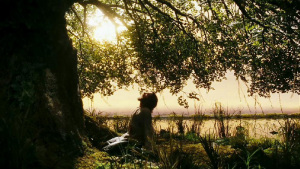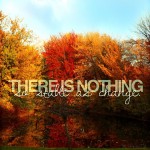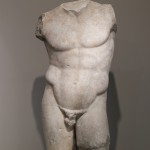Last Sunday, at the Spirit Circle at my Unitarian church discuss movies that inspire us. There are a lot of movies I find inspiring. One I recently watched was Fly Away Home with a young Anna Paquin, about a girl that rescues a flock of geese and then guides them to a mating ground in an ultralight. It’s sentimental, but I’m a sucker for that kind of stuff. I admit I cried. Another is one that someone in the Spirit Circle mentioned, The Shawshank Redemption. And my favorite inspiring movie is Gattaca. When Ethan Hawke’s character is racing his brother swimming in the ocean, and his brother yells, “We have to go back!”, and Hawke’s character says, “No, we’re closer to the other side!” — my spirit soars!
But there are a couple of movies that I consider to be truly sacred (Gattaca comes close):
The Fountain
[BEWARE! SPOILER ALERT!]
The number one spiritual movie for me is The Fountain by Darren Aronofsky. Most critics hated this movie and it was not well received by the general public. To me, this movie is a revelation. It is my all time favorite movie.
The Fountain tells the story of a scientist (Hugh Jackman) who is searching for a cure to cancer, so that he can cure is ailing wife (Rachel Weisz). In the process, he accidentally discovers a cure for aging, the secret of immortality.
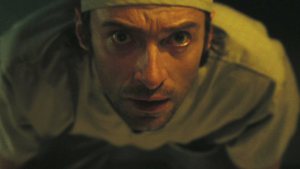 The movie switches back and forth between three time periods. There is the present day in which the main character’s wife is dying. She is writing a story about a conquistador (played by Jackman) who is sent to the New World by the Queen of Spain (played by Weisz) to discover the secret of immortality.
The movie switches back and forth between three time periods. There is the present day in which the main character’s wife is dying. She is writing a story about a conquistador (played by Jackman) who is sent to the New World by the Queen of Spain (played by Weisz) to discover the secret of immortality.
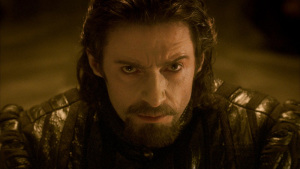 The secret is actually a “tree of life” that is hidden on the top of Mayan pyramid in the middle of the jungle and guarded by a Mayan priest. This is the second setting.
The secret is actually a “tree of life” that is hidden on the top of Mayan pyramid in the middle of the jungle and guarded by a Mayan priest. This is the second setting.
The third setting is in space, far in the future where the scientist played by Jackman is a cosmonaut traveling in a transparent bubble containing a tree (yes, you read that right) to Xibalba, a nebula that the Mayans believed was the underworld. A star in the nebula is dying and is about to explode. Jackman’s character consumes small pieces of the bark of the tree to prolong his life. He is trying to get there before the tree dies. On the way he suffers from hallucinations of his dead wife.
 The tree, we learn, is somehow identified with Weisz’s character, she having died in the present day setting. Jackman talks to the tree and clearly believes his wife somehow survived in the tree.
The tree, we learn, is somehow identified with Weisz’s character, she having died in the present day setting. Jackman talks to the tree and clearly believes his wife somehow survived in the tree.
The tree is what ties the three settings together. The scientist in the present day setting discovers the secret to immortality using a compound from a seed from the rainforest. We are left to infer that the origin of the seed is the same tree of life from the Mayan setting.
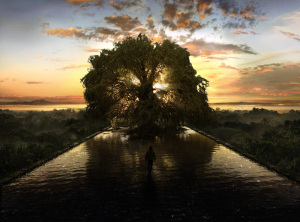 After his wife dies, the scientist takes one of these seeds and plants it where his wife is buried.
After his wife dies, the scientist takes one of these seeds and plants it where his wife is buried.
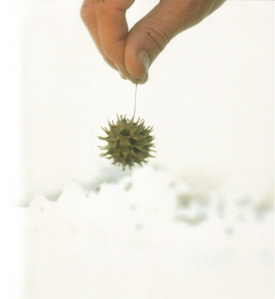 The seed then grows into the tree which the cosmonaut is taking to Xibalba, in the hopes that his wife will be resurrected.
The seed then grows into the tree which the cosmonaut is taking to Xibalba, in the hopes that his wife will be resurrected.
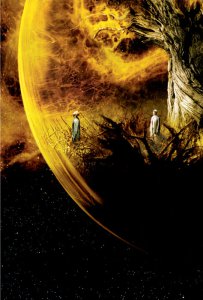 Through it all Wiesz’s character keeps telling Jackman’s character that he needs to finish the story she was writing, she having left the last chapter blank. He keeps responding that he doesn’t know how it ends.
Through it all Wiesz’s character keeps telling Jackman’s character that he needs to finish the story she was writing, she having left the last chapter blank. He keeps responding that he doesn’t know how it ends.
The conquistador ultimately reaches the tree of life, but when he drinks of the sap of the tree, flowers start bursting through his body and his body is consumed like some kind of super-compost.
This is one of the most shocking scenes in the movie. We see in stark terms how life and death are interconnected in strange ways.
The climax of the movie is when the cosmonaut realizes how the story ends: he realizes that he is going to die. He then proceeds to sacrifice himself so that the tree can briefly flower and then, when the nebula explodes, its seeds will be scattered all over the cosmos.

 The Fountain is a visually stunning movie. The soundtrack is epic. And it is the most perfect expression of the theme of palingenesis which is at the heart of my understanding of Neopaganism: death realized as a creative act, and immortality achieved through the eternal recurrence of birth.
The Fountain is a visually stunning movie. The soundtrack is epic. And it is the most perfect expression of the theme of palingenesis which is at the heart of my understanding of Neopaganism: death realized as a creative act, and immortality achieved through the eternal recurrence of birth.
Joseph Campbell writes that all creative acts derive from some sort of dying.
“The hero is the man of self-achieved submission. But submission to what? That precisely is the riddle that today we have to ask ourselves and that it is everywhere the primary virtue and historic deed of the hero to have solved. … Schism in the soul, schism in the body social, will not be resolved by any scheme of return to the good old days (archaism), or by programs guaranteed to render an ideal projected future (futurism), or even by the most realistic, hardhearted work to weld together again the deteriorating elements. Only birth can conquer death — the birth, not of the old thing again, but of something new. Within the soul, within the body social, there must be — if we are to experience long survival — continuous ‘recurrence of birth’ (palingenesia) to nullify the unremitting recurrences of death. For it is by means of our own victories, if we are not regenerated, that the work of Nemesis is wrought: doom breaks from the shell of our very virtue. Peace then is a snare; war is a snare; change is a snare; permanence a snare. When our day is come for the victory of death, death closes in; there is nothing we can do, except be crucified – and resurrected; dismembered totally, and then reborn.”

